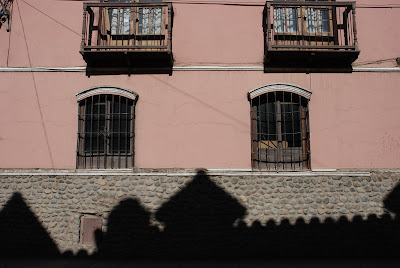It is heavy and heart-breaking to know how the Spaniards treated the indigenous people. Thousands of people died inside the silver mines.
I went on a tour to visit the mines of Cerro Rico where local people are still working for the mineral. Though Silver is very difficult to discover now.
Once rich in Silver, the mine Cerro Rico is overlooking the city of Potosi.

The mountain looks as if it is spilled with the blood of the miners.

Before we set off to the mine, the guide bought us to the miner's market to buy some gifts for the miners, such as explosive material(!!you can never buy it back home!!),coca leaves and their catalysts, some drinks and cigarettes etc.
This is the explosive material we were going to buy. And we needed to dress funny in order to enter the mine.

Before entering the mine, the guide showed us how to make a bomb!

She was putting the bomb far enough so as to not hurting ourselves...After about 1minute, the bomb did exploded as planned. But the magnitude of the explosion was out of my expectation. There is a huge roaring sound and the whole ground was shaken.

The view of the city from Cerro Rico.

Finally, we apporached the entrance of the mine.

At first, as my book mentioned, I thought the mine would be as hot as 40 degree. However, when we crawled down one level after another, the air inside was actually refreshing, although it was very dusty.
It was mainly because we didn't go down to the bottom of the mine. Down there, due to poor ventilation, temperature could rise up to 40 degree.
The dim-light torch lightened the mine.

The miners faded away into the darkness inside the mine.

Every day, the workers work for at least 8 hours. They don't eat at all, as coming out of the mine for lunch or snack is time-consuming. And they eat coca leaves with the catalysts instead. That makes them forget about hunger and thrist.

The God for the miners, which they believed it can help them to find silver. They worship him with cigarette, coca leaves and alcohol.

After about 1 hour in the mine, we reached the sunlight again. It is difficult to imagine how the miners work there day by day without any sunshine.

It was very difficult to take pictures inside the mines, my camera was covered in dust (even though I had put protection on it) and my lens was half-broken after the mine....(it was another story, I will talk about that when I write about Argentina).
Besides the sad history, Potosi is also world Cultural Heritage site, as it preserved some of the most beautiful buildings in Bolivia, dating back to the time when the spaniards ruled over the country.
The Cathedral and the geogrous landscape of Potosi.

A look over the city.

I enjoyed staying at the top of the building and watched how the clouds were changing in the sky.

One day, I followed my book and did some "treasure hunting" for beautiful or speical houses.
Doorway with two lions.

Doorway with suns.

The passage of the seven turns. But I have lost the count. Instead, I was dispelled by the barking dogs in front of their houses.

Casa de las tres portadas. The camera could not capture the 3 doors which were widely aparted.

A beautiful door.

A beautiful day in Potosi.

I like the reflection on the wall.

沒有留言:
發佈留言